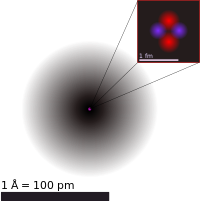
Photo from wikipedia
Through a data-mining and high-throughput density functional theory approach, we identify a diverse range of metallic compounds that are predicted to have transition metals with “free-atom-like” d states that are… Click to show full abstract
Through a data-mining and high-throughput density functional theory approach, we identify a diverse range of metallic compounds that are predicted to have transition metals with “free-atom-like” d states that are highly localized in terms of their energetic distribution. Design principles that favor the formation of localized d states are uncovered, among which we note that site isolation is often necessary but that the dilute limit, as in most single-atom alloys, is not a pre-requisite. Additionally, the majority of localized d state transition metals identified from the computational screening study exhibit partial anionic character due to charge transfer from neighboring metal species. Using CO as a representative probe molecule, we show that localized d states for Rh, Ir, Pd, and Pt tend to reduce the binding strength of CO compared to their pure elemental analogues, whereas this does not occur as consistently for the Cu binding sites. These trends are rationalized through the d-band model, which suggests that the significantly reduced d-band width results in an increased orthogonalization energy penalty upon CO chemisorption. With the multitude of inorganic solids that are predicted to have highly localized d states, the results of the screening study are likely to result in new avenues for heterogeneous catalyst design from an electronic structure perspective.
Journal Title: Chemical Science
Year Published: 2023
Link to full text (if available)
Share on Social Media: Sign Up to like & get
recommendations!